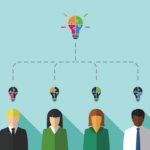
Sometimes in order to get things done, futurethink CEO and founder Lisa Bodell was saying, “You have to stop doing things.” It’s counterintuitive advice, made even more so by the fact that the Manhattan offices of BodelFs global innovation-training company, where Convene interviewed Bodell about her Opening General Session presentation at Convening Leaders 2014, were percolating with energy.
The walls were covered, bulletin-board style, with handwritten lists outlining strategies and goals. Bodell remained in constant motion until we settled into her office to talk, fetching a glass of water and introducing me to every member of her staff.
Behind Bodell was a stack of the most recent translations of her acclaimed 2012 business book, Kill the Company, the title of which felt a little contrary to the cheerful environment. But figuratively “killing” a company — fearlessly identifying your own weaknesses and vulnerabilities, as well as rooting out the “twin viruses of negativity and complacency” — is a crucial first step toward innovation, she writes. “People think that in order to change behavior, you have to start doing something — you have to start creating ideas,” said Bodell, whose long roster of clients includes HBO, IBM, Wachovia, and The Economist. “But in order for people to think differently, you have to get rid of what is not working first, to make space for things that will work better.”
How important is it to follow your advice in that exact order: to first clear things out before adding anything?
It’s the central part of the book…. People cannot add one more thing to their to-do list. It makes them anti-innovation and it feels like it’s a chore, versus a joy. When you’re busy and you’re stressed, change and upending the status quo is the last thing you want to do. You want consistency. You want things to be easy. We have to show [our clients] that innovation is not hard. Let’s start by getting rid of stuff.
You come down pretty hard on meetings in your book. In what ways do meetings stifle innovation and increase complacency in organizations?
We’re terrible at meetings. No matter what the topic or objective, we tend to do the same thing every time. Let’s say that you’re brainstorming for a new product — you still meet in the same conference room. You’re doing strategic planning for next year — and you still meet in the same conference room. You run the meeting and you sit in the same place no matter what the objective is.
The other thing about meetings that stifles creativity is that there’s a formula, right? There’s an agenda. You show up, you check in and you get your badge, you get your packet, and you sit down. Everything is an hour. There’s a break. There’s networking. The formula is so well known that it gives people comfort.
However, comfort breeds complacency and it makes things unproductive. If you really want people to pay attention, then you have to do something different with meetings. You have to match the meeting, the setting, and the agenda to what you’re trying to accomplish. If you don’t want people to be complacent, then you have to do something differently.
How can meeting planners who work in organizations increase their influence at the executive level?
Stop being a function or a back-office role, and start being a group that brings increased efficiency, productivity, and ROI to groups. Be a strategic player — be prepared with ideas that will help groups strategically, and approach each meeting with a strategic plan in mind. This elevates the role. That’s the mindset you want.
Do some research. Have you asked people what they need from you? What they like about meetings? What they wish they had? What their dream meeting would accomplish? Doing this could help arm you with statistics — and the strategic fodder to get more budget — to run better meetings.
Be more creative in your approach — you know what people think of meetings. Make great meetings commonplace, not exceptions to the rule. Build your Rolodex of vendors that can give you different venues, thought leadership, props, and inspiration that teams can try.
In Kill the Company, you write about a large conference where rigid adherence to the schedule trumped meaningful interactions that were taking place. Do you have suggestions for how conference organizers can be more flexible and responsive? Is staying on schedule a value that is overrated?
The key to successful meetings is to be excellent at logistics, and even better at alternative scenarios. You’re like an air-traffic controller — you have a schedule, but when the weather changes, flights are delayed, or traffic happens, you calmly keep things moving.
The key is to operate with guardrails, not handcuffs. What that means is, know what is supposed to happen, and have some things in your back pocket so things can flex. Things end early? Position it as added networking time.
Staying on schedule is important — people simply lack time these days. However, the point is that it can’t be the only thing. Staying on time is table stakes; what you do within that time is more important. And if you end early, no one complains if it’s spun right. They still have to perceive value from the event.
Many of the tools that you provide in Kill the Company and through futurethink are both hands-on and visual. Can you talk about the role of interactivity and visuals in your work?
People want to be inspired. That’s what motivates them to change. Once they’re in that mindset, they want to act on it — now. That’s why our tools are interactive — do it versus read it — and visual. We live in a YouTube, online world where people’s expectations are higher, and getting their attention demands more visual communication.
As a frequent keynoter, what processes do you encounter at meetings that need rethinking?
Most meetings are the same — I can predict how they’ll work. People are basically checking the box. Agenda? Check. Nametags? Check. Conference room? Check. Pre-session logistics? Check. If you do these things, you are of course technically doing your job. But rethinking the meeting is what makes it great. I mean everything.
If you want people to better engage, you do have to shake up how you run the meeting. But you have to do it in what we call “little big” ways, where people still feel comfortable. People don’t want to show up to a funky space and feel very uncomfortable — then you’re spending too much time getting them adjusted.
You want to do little things that constantly keep [attendees’] antennae up. [At meetings I attend], some of the best things they do is have their own version of “little bigs” — a series of 20 people who get up and can’t present for more than five minutes. The buzzer goes off, and the next person comes up and has to present a mind-blowing idea in five minutes. The buzzer goes off, and it’s the next person on stage.
This is the most attended part of the event;… it’s efficient, it’s effective, it’s mind-blowing, and it’s different, but it’s still in a room and it’s on a stage. A lot of it is PowerPoint. The usual constructs that people feel comfortable with are there, but how it’s delivered is different.
Another idea is to create a “living wall” where every conference attendee can add two or three resources, and by the end of the conference, you have hundreds of resources — you can take a picture and send it out. It also creates dialogue and gets participation.
And do icebreakers to manage the energy. Before the start of every presentation, [say something like,] “I need everyone to stand up and raise the hand that they write with” — that is the same hand you high-five with, and you have to go around and high-five 10 people. People love little stuff like that. We’ve done rock-paper-scissors. We’ve done conga lines. There are little things that, when you pepper them in throughout, people laugh, and some people think it’s stupid, but they all participate. What that does is it gets their cognitive thinking going again. You talked about complacency, but some of it is physiology. The longer you sit, the more you fall asleep. The more you get [attendees up] and doing what we call kinesthetic learning, the more likely they are to engage.
You and your team conduct workshops all over the world. Do you adapt your techniques to differences in international cultures? If so, do you have suggestions about how to make those changes?
Knowing your audience — industry, level and age, cultural background — is key. What works with a Latin American audience may bomb with an Asian one. We do adapt techniques to take into account cultural norms. In an Asian group, we might need to be more sensitive to the respect for hierarchy and group responses versus individual ones. We have to adapt our readouts during exercises to accommodate that. Similarly, Latin American cultures can be more expressive and talkative. We build in more discussion time in those cultures.
That said, beware of stereotypes. It’s a global world, and people in meetings now tend to come from all over. You shouldn’t make assumptions; you need to ask someone about a group’s makeup and their recommendations on how to best adjust your approach — that’s safest.



